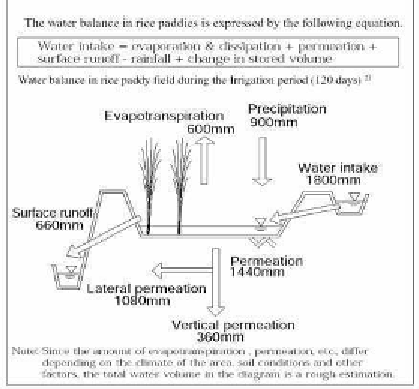Agriculture Reference
In-Depth Information
Table 4. Lines, length and authority of rivers controlled by the River Act
Class
Lines
Authority
Length
Ratio
Minimum flow
Class 1 River
National Government
10,553km
7%
Regulated
13,979
Local Governments
77,008km
54%
Regulated
Total
87,560km
61%
Class 2 River
7,071
Local Governments
35,934km
25%
Regulated
Quasi-class River
14,113
Municipalities
20,032km
14%
Regulated
TOTAL
143,528km
100%
Source:
River authority in Japan (2002).
Agricultural water users are controlled by the River Act in Japan when they take
water from a river. Moreover, the greater part of water taken from a river for rice paddy
irrigation is not consumed, i.e. it is evapo-transpired.
Figure 5 illustrates the water
balance in typically irrigated rice paddies. The water taken from a river and not consumed
in paddy fields contributes to enhancing ecosystem services in two ways: a) water in the
total paddy irrigation and drainage system serves as a network of wetlands and water
ways, and creates another excellent secondary natural environment outside the river with
an enriched flora and fauna; b) water drained from paddies and returning to the river
reinforces the ecosystems inside the downstream rivers and marshes.
Figure 5. Water balance in paddy (Japan)
Source:
Maruyama, T., R. Nakamura et al. (1998).
Paddy fields stretching along a river serve as a retardant reservoir that receives
outflow from the mountainous hinterlands and irrigated water drawn from the river, and
that gradually supplies the water to groundwater aquifer and the downstream river.
Figure 6
shows a schematic drawing and Figure 7
shows a diagram explaining the
contribution system of rice paddy irrigation to ecosystem services. This system is widely
observed in humid regions such as the Asian monsoon region. Figure 8 shows a diagram
explaining the typical arguments advocating a competitive relation between agricultural
water use and ecosystems where water is constantly scarce. It contrasts the contribution
system in humid regions with the competitive nature of water use in arid and semi-arid
regions.





Search WWH ::

Custom Search